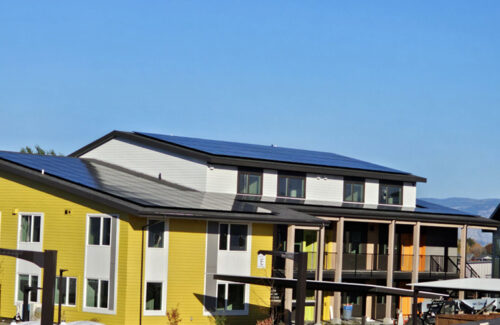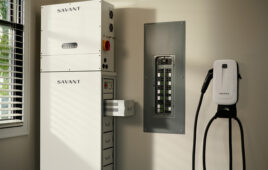For solar contractors working in agricultural communities, substantial projects are commonly ground-mounted and built across many acres of fields and farmland. Bucking this trend, a solar company from a rural county in northeast Oregon has become a regional authority in building PV projects on affordable housing developments, and the contractor’s work can now be found across the state.

With the help of a multi-famly housing developer, Enterprise Electric has expanded its reach as a solar contractor, building projects all across the state of Oregon.
Enterprise Electric (No. 210 on the 2024 Top Solar Contractors List) is a residential and commercial solar contractor born from an electrical contracting business that started in 1970 in Enterprise, Oregon. The company dabbled in off-grid solar construction in the ’80s and ’90s before entering the market in earnest around 2008 as the domestic PV industry started picking up steam.
“We’ve always been very diversified in what we do,” said Jared Hillock, electrician and co-owner of Enterprise Electric. “We’re in a small, rural community, so to stay busy, if somebody comes in the office and asks us to do something, we figure out how to do it, even if we don’t know how.”
Enterprise Electric gained experience in solar construction by assisting a local PV contractor with custom carport and tracker installations. That solar business eventually shuttered, but Enterprise Electric carried the torch and started picking up projects of its own in Wallowa County and beyond.
It was an ideal time to enter the market, Hillock said, because Oregon was offering substantial tax credits for solar projects. Compounded with the recently introduced 30% federal investment tax credit, project owners could subsidize most, if not all, of the cost of a solar project through tax credits.
Enterprise made its name in solar by building municipal projects and seeking out investors with tax burdens that would be interested in the green subsidies. Then about five years ago, the company started working on solar projects with Fleet Development, an affordable housing developer focused on building multifamily housing projects powered by renewable energy.
“We’ve worked with the apartment company for years,” Hillock said. “They’ve been around for 50 years, we’ve been around for 50 years, so we’ve always known each other. We’ve always done their electrical work.”

Enterprise Electric has learned to adapt to the many stipulations utilities have for multi-metered solar projects.
Over the last several years, building solar arrays on Fleet Development housing projects has brought Enterprise Electric across Oregon and even into Washington. No two projects on multifamily housing are the same, because every roof layout is different. Each utility also has its own stipulations for tying solar into multi-metered properties, and Enterprise Electric contractors have adapted meters into many different configurations depending on the interconnection scenarios.
“You may have a six pack of meters, and one utility may let you put all the solar on one meter and let you credit the other meters, and the next utility won’t let you do that,” Hillock said. “So, then you’re tying solar into six different meters. I don’t think there’s a ton of people doing affordable housing [installs] at the high level that we do, just because of the complications and the intricacies of interconnection and financing.”
Through that experience, Enterprise Electric has even started providing solar construction consultation specifically to other affordable or multifamily housing developers that have heard about the work Fleet Development is doing in the region.
In entirety, Wallowa County only has a population of around 7,500 people, despite being the ninth largest county by land mass in the state. The workforce pool isn’t the largest to pick from, but Enterprise Electric has ambitions to expand, reinvigorating its residential solar output and finding some administrative help in the office.
Despite those hurdles from growing pains, the modest team of about 20 people at Enterprise Electric is bringing solar generation to an economic class that often doesn’t have the chance to access it, well beyond the borders of Wallowa County.
“For me, pulling wire on residential houses every day was just mind-numbing. It’s so repetitive for me,” Hillock said. “I like the technology, I’ve always been into gadgets and kind of a nerd, so solar was right up my alley, and learning and figuring it out, it’s just way more fun. You’re going to a different place every day and you’re doing something different, and the customers love you for putting solar on.”
This story was featured exclusively in our 2024 Top Solar Contractors issue. See the issue and full list of top U.S. solar installers here.





” That solar business eventually shuttered, but Enterprise Electric carried the torch and started picking up projects of its own in Wallowa County and beyond.”
It seems the sweet spot for longevity in the solar PV sphere is companies that also do contract electrical work have something to fall back on when interest in solar PV tails off for whatever reason. This concept of the solar PV development has been demonstrated in the Utah Apartment complex of Soleil Lofts. This large apartment complex has solar PV on every building and a Sonnen BESS in every apartment in the complex. There are developments in Texas and Arizona has Mandalay Home developments where each development has solar PV and a Sonnen BESS in every home. These solar PV with storage communities have up around 10MWh of aggregate energy storage when the development is built out.
Mentioned expansion and growing pains in a population light county. The 2020-2021 Covid-19 forced changes in the way solar PV installation companies have been doing business. A lot of companies are using Google Maps and aerial views of properties without leaving the office or even on a smart phone out in the field. Like NRELs SolarAPP+ that also uses SolarTRACE helps with the deluge of paperwork for a solar PV system permitting, design and tax subsidy qualifications. With the ITC of 30% on solar PV and Battery Energy Storage Systems. The recent technologies has “stackable” battery modules that one can get a single battery module like the Simpliphi B6.6 with one 6.6kWh module and stack two more for 19.8kWh then drop in another three module pack later for 39.6kWh and still meet NFPA 855 at the residential level of energy storage. The home, grid agnostic/micro-grid is all possible today with the components that are available.